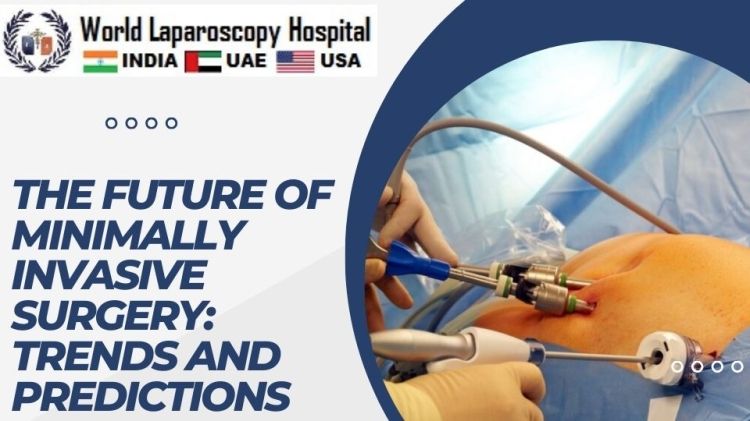Introduction:
In the rapidly evolving landscape of medical technology, the field of surgery is undergoing a transformative shift towards minimally invasive techniques. These procedures, characterized by smaller incisions, reduced trauma, and shorter recovery times, have been revolutionizing the way surgeries are performed. As we delve into the future of minimally invasive surgery (MIS), it becomes evident that a confluence of technological advancements, innovative robotics, and a growing emphasis on patient-centric care is shaping the trajectory of surgical practices.

Technological Advancements in Minimally Invasive Surgery:
Robotic Surgery:
One of the most notable trends in MIS is the integration of robotic-assisted surgery. Robots equipped with advanced imaging and precise instrumentation allow surgeons to perform complex procedures with enhanced dexterity and precision. The da Vinci Surgical System is a pioneer in this realm, and future iterations are expected to offer even greater capabilities, potentially expanding the range of surgeries amenable to robotic assistance.
Artificial Intelligence (AI) Integration:
The integration of artificial intelligence into MIS is poised to be a game-changer. AI algorithms can analyze vast amounts of patient data, assist in surgical planning, and even provide real-time feedback to surgeons during procedures. This not only enhances the accuracy of surgeries but also contributes to personalized treatment plans, optimizing outcomes for individual patients.
Augmented Reality (AR)
in Surgical Navigation: Augmented reality holds immense potential in improving surgical navigation. By overlaying digital information onto the surgeon's field of view, AR can provide real-time guidance, enhancing accuracy and reducing the risk of errors. This technology is expected to become more prevalent, especially in procedures where precise anatomical localization is crucial.
3D Printing for Custom Implants:
The use of 3D printing technology is becoming increasingly prevalent in creating custom implants and surgical tools. Surgeons can now design implants tailored to a patient's unique anatomy, leading to better outcomes and improved compatibility. This trend is expected to continue, with broader applications across various surgical specialties.
Clinical Applications and Specialty-Specific Trends:
Cardiovascular Surgery:
MIS in cardiovascular surgery is witnessing remarkable advancements, with robotic systems aiding in complex cardiac procedures. Remote-controlled catheters, capable of reaching intricate areas of the heart, are becoming standard. The future holds promise for further refinement of these technologies, potentially enabling more non-invasive interventions for heart-related conditions.
Orthopedic Surgery:
Orthopedic surgeons are increasingly adopting MIS techniques for joint replacements and spinal surgeries. Improved imaging technologies, along with robotic assistance, are enhancing the precision of implant placement. Customized implants created through 3D printing are also gaining traction, addressing the unique anatomical variations in patients.
Gastrointestinal and Colorectal Surgery:
MIS has become a cornerstone in gastrointestinal and colorectal surgeries. Robots are assisting in intricate procedures, and the use of flexible endoscopic robots is on the rise. Predictions suggest that advancements in miniaturization and maneuverability will expand the applications of these robots, making them indispensable tools in the surgeon's arsenal.
Patient-Centric Care and Outcomes:
Outpatient Minimally Invasive Procedures:
The future of MIS is closely tied to the trend of performing more procedures on an outpatient basis. Shorter recovery times and reduced hospital stays contribute to cost savings and improved patient satisfaction. Advances in anesthesia techniques and pain management further support the feasibility of outpatient MIS.
Telemedicine in Postoperative Care:
Telemedicine is playing an increasingly vital role in postoperative care. Patients can receive follow-up consultations and rehabilitation guidance remotely, minimizing the need for frequent hospital visits. This not only enhances convenience for patients but also optimizes healthcare resources.
Challenges and Ethical Considerations:
Skill Acquisition and Training:
The adoption of advanced MIS technologies necessitates specialized training for surgeons. Ensuring that healthcare professionals are proficient in utilizing robotic systems and AI tools is crucial for the successful integration of these technologies into mainstream surgical practice.
Cost and Accessibility:
While the benefits of MIS are substantial, the initial costs associated with acquiring and maintaining advanced surgical technologies can be prohibitive. Ensuring equitable access to these technologies and addressing cost concerns will be essential to realizing the full potential of MIS across diverse healthcare settings.
Ethical Considerations in Autonomous Surgery:
As robotic systems gain more autonomy, ethical considerations surrounding accountability and decision-making become paramount. Striking a balance between the benefits of automation and maintaining human oversight is crucial to ensure patient safety and uphold ethical standards in surgical practice.
Conclusion:
The future of minimally invasive surgery is an exciting frontier, shaped by a synergy of technological innovation, clinical expertise, and a commitment to patient-centered care. Robotic surgery, artificial intelligence, augmented reality, and 3D printing are propelling MIS to new heights, offering unprecedented precision and personalized approaches to treatment. As these trends continue to unfold, it is imperative for healthcare professionals, policymakers, and industry stakeholders to collaborate in navigating the challenges and ethical considerations, ultimately realizing the full potential of minimally invasive surgery for the benefit of patients worldwide.
